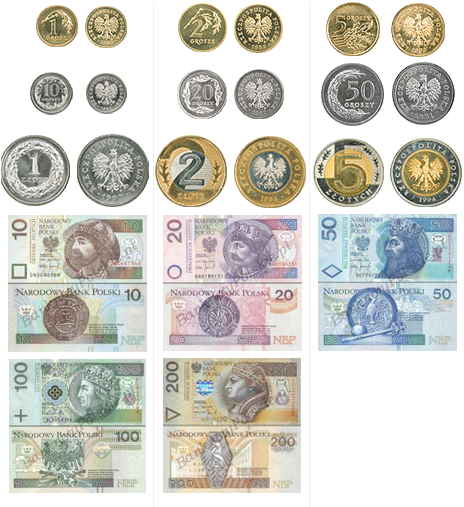Is it all about the money? Money in Poland. Posted by Kasia on Jun 2, 2015 in Uncategorized
Knowing what to do with your money is very important, especially while traveling! So, do you know everything about Polish money?
Poland’s legal tender (prawny środek płatniczy) is called Złoty (PLN).
1 złoty = 100 groszy.
Coins in circulation (monety w obiegu):
PLN 1, 2 and 5 and
1, 2, 5, 10, 20 and 50 groszy coins
Bills in circulation (banknoty w obiegu):
PLN 10, 20, 50, 100 and 200 bills.
To help the blind and partially-sighted, each Polish banknote carries a special mark – a distinctive embossed shape identifying the value of the bank note:
PLN 10 – square (kwadrat)
PLN 20 – circle (okrąg)
PLN 50 – diamond (romb)
PLN 100 – plus sign (znak plus)
PLN 200 – triangle (trójkąt)
You can exchange money everywhere in Poland, in big cities and small towns. You can use an ATM machine (bankomat) or visit a bank, currency exchange counter in town or at a hotel reception desk.
All major foreign currencies (główne waluty obce) may be exchanged for Polish money at a bank or exchange counter (kantor). Over the counter exchange is available at larger hotels, at border crossings or in dedicated outlets across towns and cities.
Banks in larger cities are usually open from 9 am to 4 pm on weekdays and until 1 pm on Saturdays. Kantors are usually open from 9 am to 7 pm weekdays and until 2 pm on Saturdays. 24-hour services are usually available in larger major tourist centres such as train stations, border crossings and airports.
Major traveler’s cheques (czeki podróżne) can be exchanged at most of the locations above, with the exception of Kantors. Eurocheques are accepted in accordance with the standard international practice.
It is hard these days to get by without a piece of plastic in your wallet, particularly while travelling abroad, when it is neither necessary nor convenient to carry travellers cheques or cash. In Poland, the use of credit cards (karty kredytowe) is widely accepted, particularly in major towns and tourist attractions.
The most widely used cards are Europay International, MasterCard International, Visa International, and American Express, both embossed and electronic versions.
Electronic cards (Maestro, Visa Electron) can be used only in cash dispensers and at points of sale equipped with electronic card readers. Embossed cards (Eurocard/Mastercard, VISA) are not subject to such restrictions.
Please shared any Polish money tips with us in comments below:)

Build vocabulary, practice pronunciation, and more with Transparent Language Online. Available anytime, anywhere, on any device.
About the Author: Kasia
My name is Kasia Scontsas. I grew near Lublin, Poland and moved to Warsaw to study International Business. I have passion for languages: any languages! Currently I live in New Hampshire. I enjoy skiing, kayaking, biking and paddle boarding. My husband speaks a little Polish, but our daughters are fluent in it! I wanted to make sure that they can communicate with their Polish relatives in our native language. Teaching them Polish since they were born was the best thing I could have given them! I have been writing about learning Polish language and culture for Transparent Language’s Polish Blog since 2010.





Comments:
ELIE:
Kindly, i want to check if the following money are still accepted in Poland:
50 Zloty banknote 1975 Karol Swierczewski, hereafter a link to its photo: http://www.worldbanknotescoins.com/2015/04/poland-50-zloty-banknote-1975-karol-swierczewski.html